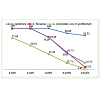Evaluation of Four Essential Oils againstAngoumois Grain Moth, Sitotroga Cerealella(Olivier)
Geetanjly and SN Tiwari*
Corresponding author: Dr. SN Tiwari, Department of Entomology, G.B. Pant University of Agriculture & Technology,Pantnagar-263145, Udham Singh Nagar (Uttarakhand);E-mail: drsntiwari@gmail.com
Department of Entomology, G.B. Pant University of Agriculture & Technology, Pantnagar-263145, Udham Singh Nagar(Uttarakhand)
Citation: Geetanjly, Tiwari SN. Evaluation of Four Essential Oils against Angoumois Grain Moth, Sitotroga Cerealella (Olivier). J Plant Sci Res. 2015;2(2): 127.
Copyright © 2015 SN Tiwari et al. This is an open access article distributed under the Creative Commons Attribution License, which permits unrestricted use, distribution, and reproduction in any medium, provided the original work is properly cited.
Journal of Plant Science & Research | ISSN: 2349-2805 | Volume: 2, Issue: 2
Submission: 25/06/2015; Accepted: 16/07/2015; Published: 22/07/2015
Abstract
Effect of four essential oils of Cinnamomum camphora (L.) J. Presl, Cymbopogon flexuosus (Nees ex Steud.) J.F. Watson, Ageratum conyzoides L.and Ocimum gratissimum L. was investigated against Sitotroga cerealella (Oliver). Oil of C. camphora was found highly effective at 0.20, 0.10, 0.05 percentconcentration (v/w), however C. flexuosus and O. gratissimum were effective only at higher concentration of 0.20, 0.10% (v/w). Essential oil of A. conyzoideswas not much effective against S. cerealellaat all concentrations tested. The efficacy of essential oils increased with the increase in dose.
Keywords: Fumigant toxicity; Essential oils; Sitotroga cerealella; Cinnamomum camphora; Cymbopogon flexuosus; Ageratum conyzoide; Ocimum
Introduction
The Angoumois grain moth, Sitotroga cerealella (Olivier)(Lepidoptera: Gelechiidae) is a major pest of cereals, especially rice,wheat, barley, maize and sorghum under storage condition [1-7].Although, its infestation may start from the field, severe damage iscaused under storage conditions [8] leading to extensive qualitative aswell as quantitative loss [9]. The management of this pest is basicallydependent on use of organophosphates such as phoxim, malathion,methacrifos, tetrachlorvinphos, pirimiphos methyl, fenitrothion,fenthion and dichlorvos [10-14] pyrethroids such as fenvalerate,cyfluthrin, deltamethrin and permethrin [15] or fumigation withaluminium phosphide and methyl bromide [16]. However, frequentuse of insecticides or fumigants have resulted in the developmentof resistance, environmental and food contamination and toxicityto non-target organisms [17] and in many countries they are not permitted to be used without technical supervision. In view of theselimitations a necessity is being felt since long to develop effective, safe and economical non-chemical alternative for controlling insect pestsunder storage condition. Among the available options, essential oilsand their constituents have been found to have potential for replacingthe chemicals in short and medium small scale storage [18-27].Essential oils are complex mixtures of volatile organic compoundsproduced as secondary metabolites in plants. They contain mainlyhydrocarbons (terpenes and sesquiterpenes) and oxygenatedcompounds (alcohols, esters, ethers, aldehydes, ketones, lactones,phenols and phenol ethers) [28]. Most of these compounds have beenreported to possess fumigant toxicity against stored grain pests [29-34]. In the present investigation an attempt has been made to studythe effect of essential oils of Cinnamomum camphora, Cymbopogonflexuosus, Ageratum conyzoides and Ocimum gratissimum against S.cerealella.
Materials and Methods
Insect culture
Pure culture of test insect (S. cerealella) was developed in thePost-Harvest Entomology Laboratory of Department of Entomology,G.B. Pant University of Agriculture and Technology, Pantnagar,Udham Singh Nagar at 27+1 °C temperature and 70+5% relativehumidity. Adults used for this study were reared on the grain ofwheat variety PBW-343after disinfestation in the oven at 60 °C for12 h. The moisture content of disinfested grain was raised to 13.5%by mixing water in the grain. The quantity of water required to raisethe moisture content was calculated by using following formula asdescribed by Pixton [35].

W1 = Initial weight of grain
M1 = Initial moisture content
M2 = Final moisture content
After mixing the water in the grain it was kept in closed polythenebags for a week so that moisture content of the grain could equilibrate.The grain was then filled in plastic jars (2 kg capacity) the mouth ofwhich was covered with muslin cloth.Approximately 50 adults werereleased in each jar after which it was kept in control room. Firstgeneration adults (0-3 days old) were used for experimental purpose.
Extraction of essential oils
Fresh plant leaf of experimental plants were collected fromMedicinal Research and Development Center, GBPUA&T Pantnagar.Semi-dried plant material (leaf) was subjected to steam distillation toobtain the essential oils. The distillation process was carried out usinga Clevenger Apparatus [36]. Anhydrous sodium sulphate was usedto remove trace of moisture from essential oil and stored in air tightcontainer in a refrigerator at 4 °C [Table 1].
Experimental details
The experiment was conducted under controlled conditions at27+1 °C temperature and 70+5% relative humidity in the plastic vials(10×4cm). The study was made two times to confirm the efficacy ofoils. Fifty gram wheat grain (moisture content 13.5%) filled in plasticvials was treated with essential oils at the rate of 0.20, 0.10, 0.05, 0.025 and 0.012% concentration (v/w). Measured quantity of oil was pouredon the absorbing paper mat, which was then inserted in the grain.After releasing 10 adults of test insect in each vial, its screw cap wasclosed tightly and made completely airtight by sealing with parafilmstrip. Each treatment was replicated thrice. Untreated grain was usedas control. Insects were then allowed to complete one generation afterwhich observation was recorded on F1 progeny by counting adultsemerged in each vial. The emerging adults were counted thrice andtheir sum was used to calculate the number of adults emerged in eachvial. The efficacy of oils was classified in different categories on thebasis of F1 progeny production. Treatments inhibiting more than90% F1 progeny were classified as highly effective while inhibitionof 80-89 and 70-79% were ranked as moderately and less effective,respectively. Similarly, essential oil concentrations suppressing lessthan 70% F1 progeny were ranked as least effective.
Statistical Analysis
Data was analyzed in Completely Randomized Design afterSquare root (X+0.5) transformation. Data processing was conductedin STPR 3 program.
Results and Discussion
The study revealed that all the essential oils suppressed thedevelopment of the S. cerealella; however, the level of inhibitionwas highly correlated with the dose [Table 2]. The essential oil ofC.camphora was most effective as it completely checked the F1progeny of S. cerealella at 0.20, 0.10 and 0.05% while 88.06 and 82.52%inhibition was obtained at 0.025 and 0.012%, respectively.
The essential oil of C. flexuosus inhibited 100 percent progenyof test insect at 0.20 and 0.10% during 1st and 2nd test, however, its efficacy declined significantly at lower dosages. This oil has alsobeen reported to be effective against Tribolium castaneum [37,38].In another study essential oil of Cymbopogon martini was toxic toOryzaephilus surinamensis (L.) with LC50 values of 37.2 mL/L air[39].
The development of S. cerealella was not much affected by theessential oil of A. conyzoides which suppressed only 77.08% progenyproduction even at its highest concentration of 0.20 percent whichdecreased further to 58.35 and 37.35% at 0.10 and 0.05%, respectively.However, in a contact toxicity bioassay the adults of C. maculatuswere susceptible to this oil, where LC50’s ranged between 37.1 to110.8 ml/cm2 after treatment for 96 h. In another test LC50’s rangedfrom 71.6 to 161.9 ml/l air and 19.2 to 77.8 ml/l air against eggs andadults, respectively [40].
The essential oil of O. gratissimum was also highly effective againstS. cerealella as it suppressed 100 % progeny of this insect at 0.20 and0.10% concentration. However, the oil was not much effective atlower dosages. Ngamo et al. [41] observed that oil of O. gratissimumcaused 74% adult mortality against Sitophilus zeamais within 4 daysof ingestion. In another study Ogendo et al. [42] reported that oilof O.gratissimum caused 98, 99 and 100 percent mortality of R.dominica, O. surinamensis (L.) and C. chinensis, respectively, at 1micro L/L air, while T. castaneum was tolerant.
The study revealed that essential oil of C.camphora wasmost effective against S. cerealella as it completely suppressedthe development of this insect even at 0.05 percent. In case of C.flexuosus and O. gratissimum such high efficacy was found at 0.10%.As compared to these essential oils, low efficacy was observed in A.conyzoides [Figure 1].
References
- Champ BR, Dyte CE (1977) FAO Global Survey of Pesticide Susceptibility of Stored Grain Pests. FAO Plant Protection Bulletin 25: 49-67.
- Bhardwaj AK, Srivastava PK, Girish GK (1977) Assessment of storage losses in wheat due to insect damage in Punjab. Bulletin of Grain Technology 15: 126-129.
- Gupta GP (1983) Losses to stored grains by insects in Andamans. Bulletin of Grain Technology 21: 79-82.
- Dakshinamurthy A, Regupathy A (1988) Alternate rice field hosts of the Angoumois grain moth. International Rice Research Newsletter 13: 42-43.
- Ramashrit S, Mishra SB (1989) Insect pests of rice and paddy in storage and their control. Seeds and Farms 15: 16-19.
- Dhaliwal HS, Deol GS, Randhawa AS (1989) A new technique for large scale screening of wheat varieties against Angoumois grain moth, Sitotroga cerealella Oliver (Gelechiidae: Lepidoptera). Indian Journal of Entomology 51: 94-95.
- Visalakshi M, Gour TB, Ramulu MS (2005) Relative abundance of stored grain pests in maize. Journal of Research ANGRAU 33: 96-102.
- Schulten GGM (1973) Beginning and progression of maize infestation. Tropical Stored Products Information 25:16-17.
- Sedlasek JD, Komaravalli SR, Hanley AM, Price BD, Davis PM (2001) Life history attributes of Indian meal moth (Lepidoptera: Pyralidae) and Angoumois grain moth (Lepidoptera: Gelechiidae) reared on transgenic corn kernels. J Econ Entomol 94: 586-592.
- Rai BK, Croal K (1973) Chemical control of Sitotroga cerealella (Olivier) infesting paddy stored in bags. Indian Journal of Entomology 35: 57-62.
- Bitran EA, Campos TB, Oliveira DA, Araujo JBM (1976) Test on the protection of stored maize in the husk, in relation to attack by Sitophilus zeamais Motschulsky, 1855 and Sitotroga cerealella (Oliver, 1819). Arquivos do Instituto Biologico 43: 57-63.
- Kao SS, Tzeng CC (1992) A survey of the susceptibility of rice moth (Corcyra cephalonica) and Angoumois grain moth (Sitotroga cerealella) to malathion and phoxim. Chinese Journal of Entomology 1: 239-245.
- Weaving AJS (1981) Grain protectants for use under tribal storage conditions in Zimbabwe (Rhodesia). Evaluation of admixtures with maize stored in traditional grain bins. Zimbabwe Journal of Agricultural Research 19: 205-224.
- Hashem MY, Risha EM, El-Sherif SI, Ahmed SS (2012) The effect of modified atmospheres, an alternative to methyl bromide, on the susceptibility of immature stages of angoumois grain moth Sitotroga cerealella (Olivier) (Lepidoptera: Gelechiidae). J Stored Prod Res 50: 57-61.
- Hung CC, Hsieh FK, Hwang JS (1990) Stored grain insects monitoring and their chemical control. Chinese Journal of Entomology 10: 169-179.
- Fields PG, White ND (2002) Alternative to Methyl bromide treatemnets for stored-product and quarantine insects. Annu Rev Entomol 47: 331-359.
- Tavares WS, Freitas SS, Grazziotti GH, Parente LML, Lião LM, et al. (2013) Ar-turmerone from Curcuma longa (Zingiberaceae) rhizomes and effects on Sitophilus zeamais (Coleoptera: Curculionidae) and Spodoptera frugiperda (Lepidoptera: Noctuidae). Ind Crops Prod 46: 158-164.
- Singh D, Siddiqui S, Sharma S (1989) Reproduction redardent and fumigant properties in essential oils against Rice weevil (coleopteran: Curculionidae) in stored wheat. J Econ Entomol 8: 727-732.
- Singh V, Dayal R, Bhandari RS (2002) Pesticidal activity of essential oil of Vitex negundo leaves against Sitotroga cerealella. Shashpa 9: 71-75.
- Shaaya E, Ravid U, paster N, Juven B, Zisman U, et al. (1991) Fumigant toxicity of essential oils against four major stored products insects. J Chem Ecol 17: 499-504.
- Shaaya E, Kostjukovski M, Eilberg J, Sukprakarn C (1997) Plant oils as fumigants and contact insecticides for the control of stored-product insect. J Stored Prod Res 33: 7-15.
- Regnault-Roger C, Hamraoui A, Holeman M, Theron E, Pinel R (1993) Insecticidal effect of essential oils from Mediterranean plants up on Acanthoscelidsobtectus (Say) (Coleoptera: Bruchidae), a pest of kidney bean (Phaseolus vulgaris L.). J Chem Ecol 14: 1965-1975.
- Dunkel FV, Sears J (1998) Fumigant property of physical preparations from mountain big sagebrush, Artemisia tridentate Nutt. Spp. Vaseyana (Rydb.) beetle for stored grain insects. J Stored Prod Res 34: 307-321.
- Huang Y, Ho SH (1998) Toxicity and antifeedant activity of Cinameldyhide against the grain storage insects, Tribolium casteneum (Herbst) and Sitophillus zeamais Mostch. J Stored Prod Res. 34: 11-17.
- Huang Y, Lam SL, Ho SH (2000) Bioactivities of essential oil from Elettaria cardamommum (L.) Maton.to Sitophilus zeamais Motschulsky and Tribolium castaneum (Herbst). J Stored Prod Res 36: 107-117.
- Tunc I, Berger BM, Erler F, Dagli F (2000) Ovicidal activity of essential oils from five plants against two stored product insects. J Stored Prod Res. 36: 161-168.
- Lee SE, Lee BH, Choi WS, Park BS, Kim JG, Campbell BC (2001) Fumigant toxicity of volatile natural products from Korean spices and medicinal plants towards the rice weevil, Sitophilus oryzae (L.). Pest Manag Sci 57: 548-553.
- Guenther E (1972) The production of essential oils: methods of distillation, enfleurage, maceration, and extraction with volatile solvents. In: Guenther, E. (ed.). The essential oils.History-origin in plants.production analysis. Vol 1: 85-188. Krieger Publ. Co., Malabar, FL.
- Krishnarajah SR, Ganeshlingam VK, Senanayake UM (1985) Repellency and toxicity of some plants oils and their terpene components to Sitotroga cerelella (Oliver), (Lep.,Gelechidae). Tropical Sci 25: 249-252.
- Stamopoulos DC, Damos P, Karagianidou G (2007) Bioactivity of five monoterpenoid vapours to Tribolium confusum (du Val) (Coleoptera: Tenebrionidae). J Stored Prod Res 43: 571-577.
- Isikber AA, Alma MH, Kanat M, Karci A (2008) Fumigant toxicity of essential oils from Laurus nobilis and Rosmarinus officinalis against all life stages of Tribolium confusum. Phytoparasitica 34: 167-177.
- Rajendran R, Sriranjini V (2008) Plant products as fumigants for stored-product insect control. J Stored Prod Res 44: 126-135.
- Rajendran S (2001) Alternatives to methyl bromide as fumigant for stored food commodities. Pesticide Outlook 12: 249-253.
- Pixton SW (1967) Moisture content-its significance and measurement in stored product. J Stored Prod Res 3: 35-37.
- Gunter E (1946) The essential oils. Vol.III. Toronto, Van Nostrand.
- Chahal KK, Kumari M, Joia BS, Chhabra BR (2007) Chemistry and potential of lemon grass oil as stored grain protectant. Pesticide Res J 19: 141-144.
- Gallardo KC, Olivero-verbal J, Stashenko EE (2012) Repellency and toxicity of essential oils from Cymbopogon martini, Cymbopogon flexuosus and Lippia origanoides cultivated in Colombia against Tribolium castaneum. J Stored Prod Res 50: 62-65.
- Hernandez-Lambrano R, Pajaro-Castro N, Caballero-Gallardo K, Stashenko E, Olivero-Verbel J (2015) Essential oils from plants of the genus Cymbopogon as natural insecticides to control stored product pests. J Stored Prod Res. 62: 81-83.
- Nenaah GE, Ibrahim SA, Al-Assiuty BA (2015) Chemical composition, insecticidal activity and persistence of three. Asteraceae essential oils and their nanoemulsions against Callosobruchus maculatus (F.). J Stored Prod Res 61: 9-16.
- Nagmo LS, Ngassoum MB, Jirovetz L, Ousman A, Nukenine EC, et al. (2001) Protection of stored maize against Sitophilus zeamais (Motsch.) by use of essential oils of spices from Cameroon. Meded Rijksuniv Gent Fak Landbouwkd Toegep Biol Wet 66: 473-478.
- Ogendo JO, Kostyukovsky M, Ravid U, Matasyoh JC, Deng, AL, et al. (2008) Bioactivity of Ocimum gratissimum L. oil and two of its constituents against five insect pests attacking stored food products. J Stored Prod Res. 44: 328-334.
- Singh V, Dayal R, Bhandari RS (2002) Pesticidal activity of essential oil of Vitex negundo leaves against Sitotroga cerealella. Shashpa 9: 71-75.



